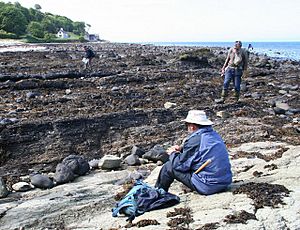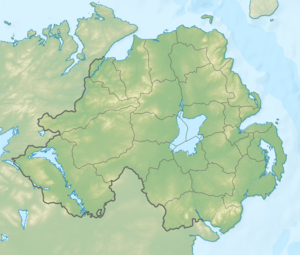Waterloo Bay facts for kids
Quick facts for kids Waterloo Bay |
|
|---|---|

Tilted mudstones at Waterloo Bay, Larne
|
|
| Location | County Antrim, Northern Ireland |
| OSI/OSNI grid | D408037 |
| Coordinates | 54°51′07″N 5°49′48″W / 54.852°N 5.83°W |
| Elevation | 0 m |
| Geology | Mercia Mudstone Group, Lias Group |
| Age | Jurassic, Triassic |
| Topo map | OSNI Discoverer 9 |
Waterloo Bay is a special place on the coast of Larne in County Antrim, Northern Ireland. It's a fantastic spot for people who study rocks, called geologists, because it shows a clear story of how the Earth changed a very long time ago. Here, you can see rocks from the Upper Triassic and Lower Jurassic periods, which helps us understand when the land changed into a sea.
Contents
Understanding Ancient Rocks
Early Discoveries
Long ago, scientists started exploring the rocks at Waterloo Bay. In 1843, a geologist named Joseph Ellison Portlock studied the Triassic and Jurassic rocks in Ireland. Later, in 1864, Ralph Tate also looked closely at the Triassic rocks in County Antrim and shared his findings with other geologists.
Why Waterloo Bay is Special
Waterloo Bay is super important because it has a very clear and complete record of rocks from the Upper Triassic to the Lower Jurassic periods. This is when the types of rocks changed from those formed on land to those formed in the sea. Because it's so unique, Waterloo Bay was named an Area of Special Scientific Interest in 1995. This means it's a protected area due to its scientific importance.
In 2007, Waterloo Bay was considered as a possible "golden spike" location. A "golden spike" (officially called a Global Boundary Stratotype Section and Point) is a special spot chosen by scientists to mark the exact start of a new period in Earth's history. Waterloo Bay was a candidate to mark the beginning of the Jurassic period, but another place in Austria was chosen instead.
The "Larne Sea Dragon"
In 1999, an amazing discovery was made at Waterloo Bay. A fossil of an ichthyosaur was found by Brian McGee. Ichthyosaurs were ancient marine reptiles, often called "sea dragons" because they looked a bit like dolphins or fish, but were reptiles. This particular fossil became known as the 'Larne Sea Dragon' or 'Minnis Monster'.
The fossil included parts of the backbone, rib cage, pieces of the front limbs, the lower jaw, and several teeth. A fossil expert named Andy Cowap carefully uncovered these remains. Today, you can see them on display at the Ulster Museum.
For a couple of years, from 2007 to 2009, while the Ulster Museum was being updated, the ichthyosaur fossil was shown at the Larne Tourist Information Centre.
Walking by the Bay
The path along the coast at Waterloo Bay is called the promenade. It's a public path that runs between the beach and the low cliffs. This means anyone can walk along it and enjoy the views.
Gallery
-
Ammonites are often found in the mudstone rocks from the Jurassic period. A key fossil here is the Psiloceras planorbis ammonite.






